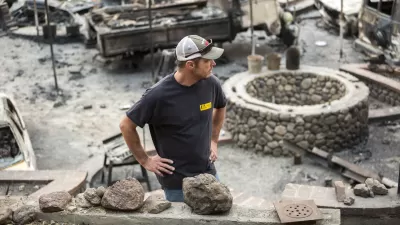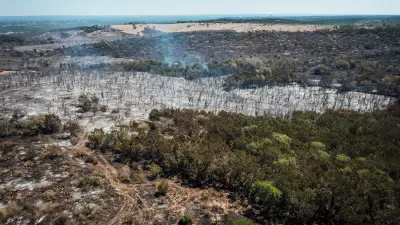Houses that aren't vulnerable to embers blowing in the wind, could save the government and homeowners millions.

Fire damage can seem random. Sometimes houses very close to each other suffer very different consequences from wildfires. Fire expert Jack Cohen encountered the kinds of hazard presented by building materials while investigating ways to combat the spread of wildfires. "People were calling in about houses on fire long before the fire front ever reached their neighborhoods," 99 Percent Invisible reports. It turned out the culprit behind these burning homes were embers carried by the winds landing on flammable wooden shingles.
While not using a flammable housing material would seem to be common sense, Cohen was able to codify the impact of design choices. Cohen's research lead to the conclusion that more emphasis should be put on building fire-resistant properties and less on fighting fires.
"In other words, if structures near fire-prone areas were designed and maintained to withstand fire, we might not need to fight some wildfires at all," 99 Percent Invisible reports. Cohen's argument is further bolstered by the sometimes counterproductive outcomes of putting out wildfires. Because where forests that have not had a burn for many years sometimes become tinder boxes of flammable material, meaning sometimes it would be better to allow a controlled burn to take place than to fight all fires.
"Last year, the federal government spent more than 2 billion dollars fighting fires and just a small fraction of that on prevention and mitigation efforts," 99 Percent Invisible writes. Shifting some of those resources might improve safety for people and property.
FULL STORY: Built to Burn

Planetizen Federal Action Tracker
A weekly monitor of how Trump’s orders and actions are impacting planners and planning in America.

Congressman Proposes Bill to Rename DC Metro “Trump Train”
The Make Autorail Great Again Act would withhold federal funding to the system until the Washington Metropolitan Area Transit Authority (WMATA), rebrands as the Washington Metropolitan Authority for Greater Access (WMAGA).

DARTSpace Platform Streamlines Dallas TOD Application Process
The Dallas transit agency hopes a shorter permitting timeline will boost transit-oriented development around rail stations.

LA County Creating Action Plan to Tackle Extreme Heat
Los Angeles County is creating a Heat Action Plan to help communities stay safe during extreme heat, with steps like adding more shade, improving buildings, and supporting the neighborhoods most at risk.

Maryland Plans Quick-Build Complete Streets Projects
The state will use low-cost interventions to improve road safety in five Maryland counties.

Downtown Los Angeles Gears Up for Growth
A new report highlights Downtown L.A.’s ongoing revival through major housing projects, adaptive reuse, hospitality growth, and preparations for global events in the years ahead.
Urban Design for Planners 1: Software Tools
This six-course series explores essential urban design concepts using open source software and equips planners with the tools they need to participate fully in the urban design process.
Planning for Universal Design
Learn the tools for implementing Universal Design in planning regulations.
City of Charlotte
Municipality of Princeton
Roanoke Valley-Alleghany Regional Commission
City of Camden Redevelopment Agency
City of Astoria
Transportation Research & Education Center (TREC) at Portland State University
US High Speed Rail Association
City of Camden Redevelopment Agency
Municipality of Princeton (NJ)





























